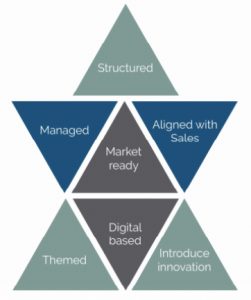 We all hope our campaign has the ‘wow’ factor. That is cuts through the noise, engages our audience and delivers results. But just what does a successful B2B tech marketing campaign look like? No two campaigns are identical but that doesn’t mean that you can’t follow a simple and successful structure. A lucrative marketing campaign doesn’t happen by accident. It takes planning, diligence, time, timing and funds.
We all hope our campaign has the ‘wow’ factor. That is cuts through the noise, engages our audience and delivers results. But just what does a successful B2B tech marketing campaign look like? No two campaigns are identical but that doesn’t mean that you can’t follow a simple and successful structure. A lucrative marketing campaign doesn’t happen by accident. It takes planning, diligence, time, timing and funds.
You want your campaign to have its desired effect. That could be to nurture new or existing customers, increase engagement, boost brand awareness, etc. There is nothing fluffy or vague here. Whatever your marketing goal, we are sharing (in detail) the 7 campaign principles for marketing success.
1. Structure
- You don’t need complex lengthy campaign plans, but you do need a campaign plan (and it must fit within your wider marketing plan to ensure its aligned). Before you dive in (creative juices flowing) invest some time in your campaign planning. It will pay off. Produce a clear and simple one-page campaign plan for each campaign – regardless of size – setting out your campaign goals, target audience, tactics, budget, etc. We can share our campaign template which covers everything to get you started.
- Think about which stakeholders need to be involved. This includes your sponsor, sales and business users. Make sure you get sign off and buy-in before any activity commences
- We’ve all been there, you get the lightbulb moment with the ‘big idea’ and are desperate to start working on the creatives. But as tempting as that is, it’s vital to spend the right amount of time and effort planning upfront before your campaign gets underway.
2. Managed
- Together, agree on what success looks like and your unified definition of it. What do you expect from the campaign? How will you measure its tangible (agreed) results? It can be tempting to deem your campaign a resounding success – it met its MQLs, however, Sales can’t work the leads. Avoid this disappointment by agreeing and quantifying your campaign results in advance.
- Next is campaign governance. Map out a clear, robust timeline. How are you going to track and report on the project? What visibility do stakeholders need and when?
- Agility and flexibility and two words bandied around a lot and, with good reason. You may need to pivot mid-way through your campaign to respond to changeable customer needs or depending on the success or challenges you face with earlier campaign tactics.
3. Market-Ready
- Product Marketing is the feeder for all marketing campaigns. New or amended propositions need to have gone through the ‘product marketing engine’ and all criteria been satisfied that they are market-ready before they can be promoted via a campaign. Are all parts of the business ready to support the results of a campaign? You may have got Sales chomping at the bit for leads, but is your pre-sales and delivery team ready should you get high-demand?
- Marketing plays a significant role in the Product Marketing function and can help influence and steer key messaging and, in particular, the key customer benefits and how your solution is to be positioned. Aside from the big idea which helps you cut through the noise with prospects, you need to be confident the product/service features and benefits hit the mark.
- If you’re working in a B2B Tech company, it’s highly likely your tech teams will talk features, they just can’t help themselves. And while features are important, they’re not nearly as important as benefits. Make sure your campaign and messaging focus on the benefits first – what difference will your product/service make to the customer, and why should they buy from you?
4. Sales and Marketing alignment
- Determine your type of campaign at the start: lead generation, brand awareness, customer nurturing, etc. Marketing traditionally owns the top of the funnel, but fast-forward to present day and Sales and Marketing both prospect and nurture – making collaboration all the more vital. Marketing should align all campaign activity with your agreed targets to ensure the split of marketing to existing and new customers is achieved.
- While attracting and signing brand new customers will require the most energy, Marketing can and should be nurturing existing customers with personalised campaigns. With acquiring a new client up to 5 times more expensive than retaining an existing one – nurturing is a cost-effective and wise technique.
5. Themes
- Each campaign needs a ‘big idea’ which will resonate with the audience and help you stand out. Take a look here at the companies who snatched the B2B Marketing trophies last year. The theme provides an anchor and consistency across your assets.
- Focus on both the creative and the copy – these will bring the story to life (don’t be afraid to go for bold copy, in line with aiming to be a ‘bit different’)
- Your language should be chosen to focus on pain-points within customer organisations (outcome-based, not product-led) and your messaging hierarchy must communicate the reasons to engage and respond. You can always stress-test campaign ideas with friendly customers or influences too.
6. Digital-Based
- You’ll have a range of tools at your disposal and you’ll want to take advantage of the most valuable resources. Digital marketing will provide the most cost-effective routes. Start with looking at your tech stack and getting feedback from wider teams on the best digital tactics.
- Make sure you’re aligning the tactics carefully against your goals. Whether you’re looking for increased web traffic, or want to raise awareness and boost engagement make sure you’re equipped to measure the success of ROI on digital activities.
- But remember, the most successful campaigns have multi-channels. Consider where your audience is, and what communication route will be most effective. Don’t just dive into email and content marketing (we are all overwhelmed by companies trying to sell to us this way). How can you stand out – think about video, interactive content and direct mail.
7. Introduce innovation
- You need to ensure you have an emotional connection with your audience, and you may need to consider new approaches. What worked with a previous sector isn’t guaranteed to work with everyone. Be curious and always on the look-out for inspiration. And don’t just limit it to B2B, often B2C ideas can transfer – remember in B2B we are selling to humans after all.
- Existing techniques that have been tried and tested should be used, but new techniques can be trialled and adopted – these may include use of video, face-to-face roundtables, PPC, direct mail, etc – don’t be afraid to try next approaches, but make sure you can measure the success and engagement of each medium.
- Your campaign team may be distributed – you may have an inhouse copy team, but external graphics team, in a different time zone. How can you keep everyone on track, remove bottlenecks and ensure everyone does their best work? Look for easy-to-use collaboration and work management tools that provide central visibility and one source of the truth (Workfront is our absolute go-to).
A successful marketing campaign requires the right send-off, attention and planning from tip to toe. Once you refine your approach and processes, your campaigns will have the success they deserve and meet your incredibly well-defined criteria.





